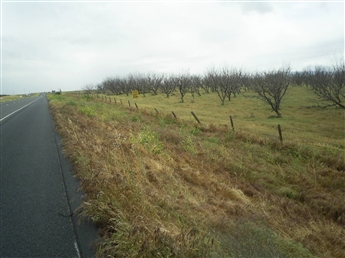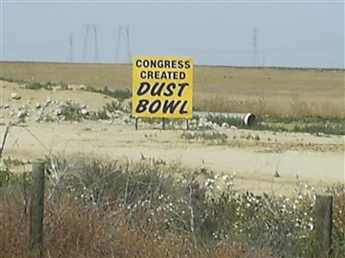
Apr 29, 2010
Investors Business Journal
By MONICA SHOWALTER
Posted 04/28/2010 07:11 PM ET
http://www.familiesprotectingthevalley.com/topstory.php?ax=v&n=99&id=99&nid=142
COALINGA, Calif. — Would France rip out its storied vineyards? Would Juan Valdez scorch Colombia's coffee crop? Sri Lanka its black pepper harvest? China its tea?
With global markets won by nations specializing in doing what they do best, and with regional reputations important enough to drive some nations to protectionism, it's almost unthinkable.
But then there's California.
On a springtime drive through the Central Valley, it's hard not to notice how federal and state governments are hell-bent on destroying the state's top export — almonds — and everything else in the nation's most productive farmland.

Along California's Highway 5, which cuts through the Central Valley, an orchard near Fresno lies dead for lack of water.
Instead of pink blossoms and green shoots along Highway 5 in April, vast spans from Bakersfield to Fresno sit bone-dry. Brown grass, dead orchards and lifeless grapevine skeletons stretch for miles for lack of water. For every fallow field, there's a sign that farmers have placed alongside the highway: "No Water = No Food," "No Water = No Jobs," "Congress Created Dust Bowl."
Locals say it's been like this for two years now, as Congress and bureaucrats cite "drought," "global warming" and "endangered species" to deny water to this $37 billion breadbasket through arbitrary "environmental" quotas.
It started with a 2008 federal court order that stopped water flowing from northern tributaries on a supposed need to protect a small fish — the delta smelt — that was getting ground up in the turbines of pump stations that divert the water south. The court knew it was bad law, but Congress refused to exempt the fish from the Endangered Species Act and the diversion didn't help the fish.
After that, the water cutoff was blamed on "drought," though northern reservoirs are currently full. Now the cry is "save the salmon," a reference to water needs of the state's northern fisheries.
Whatever the excuse, 75% of the fresh water that has historically irrigated California is now being washed to the open sea. For farmers in the southwest part of the valley, last year's cutoff amounted to 90%.
"It's pretty hard to keep crops alive at 10%," says Jim Jasper, who runs a 62-year-old almond farm in Newman that employs 170. "That's one irrigation, and trees take 10 to 12 over the growing season from March to October." Almond trees cost $8,000 per acre and take six years to start producing, so farmers reserved their 10% allocation for mature trees first.
The cutoff didn't kill just trees, however. It also devastated the area's economy. Unemployment in some valley towns has shot up to 45%. Mortgage defaults are on the rise, and food lines are lengthening.

Near Bakersfield, Calif., a farmer posts a sign blaming Congress for a sharp drop in water supplies that has slashed farm output
Call it what it is: a man-made drought.Much like organized criminals in big-city fish markets who see to it that product spoils when kickbacks aren't forthcoming, Washington's pols are now using their ability to turn water on and off as a coercion tool.
Take the three congressmen who represent the valley and how they were pressured to vote for President Obama's health care bill. It didn't go without notice by farmers like Jasper that the 5% water allocations announced in February for all three congressional districts were lifted to 25% for the two whose Democratic representatives, Jim Costa of Fresno and Dennis Cardoza of Modesto, switched their votes on health reform from "no" to "aye."
Devin Nunes, a Republican from Tulare, wouldn't sell his vote, and parts of his district had to make do with the 5% allotment.
This isn't the only way water allocation is politicized. According to Jasper, water in federal districts is distributed by 30-year contracts that guarantee water but not the quantity. Older irrigation districts get more, and newer ones (such as Jasper's, which at 60 years in operation is considered new) get less.
To win political points from time to time, federal officials announce short-term increases in allocations — most recently, to 30%. But these increments are so iffy and irregular that farmers can't plan their crops or arrange for bank loans.
Bureaucrats also do their part to ensure that drought conditions persist. Lake Shasta, which supplies the federal Central Valley Project though the Sacramento River, is so full that rice farmers upstream have plenty extra to sell. But Lake Oroville, which supplies California's State Water Project through the Feather River, while not in a drought state, is not full.
State regulations say that upstream farmers who get water from Shasta cannot sell their extra water to the Central Valley farmers because Feather River farmers along the state system must sell first. It matters not that there's a surplus on the Shasta side and a deficit on the Oroville side. Even with the orchards of about a third of the state's 6,000 almond farmers withering, state bureaucrats are hung up on pecking order.
There's no good reason to destroy California's most productive region, which turns out 85% of the world's almonds, or to coldly demonize its growers as "corporate agribusiness."
That's a favorite slur of leftist politicians, such as Bay Area Rep. George Miller, who write off the agricultural damage to global warming and drought while harming the very environment they claim they want to preserve. The valley's water table, for example, is falling as desperate farmers try to retrieve whatever supplies they can.
"What they have done is try to create a green utopia in the San Joaquin Valley, and in the process they are ruining people's lives," Nunes said.
Higher food prices are also on the way, Jasper warns. "Our cost of water to production is 25% to 30%," he says. "About a third of California almonds are affected — 280,000 acres out of 800,000."
Another unintended consequence is that much of the food Californians consume will no longer be local. Some crops will move to Mexico and then must be imported. Meanwhile, Chile, Spain and Australia have begun to develop their own almond industries.
This was made painfully obvious in a news photo datelined Mendota, Calif., and showing farm workers standing in food lines. The laborers who once picked vegetables in California's world-renowned "salad bowl" were taking handouts not of California carrots, but of baby carrots grown in China.
• Showalter is an IBD editorial writer.